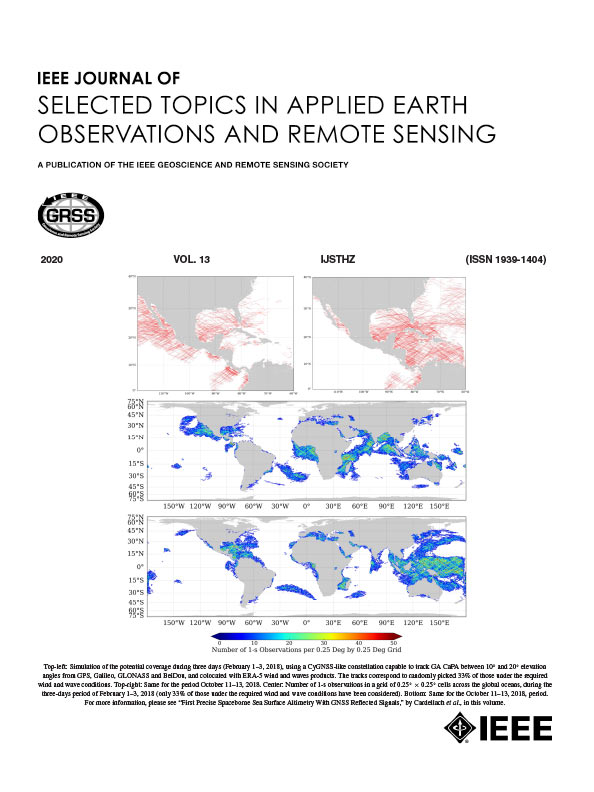A Low Signal-to-Noise Ratio Infrared Small-Target Detection Network
IF 4.7
2区 地球科学
Q1 ENGINEERING, ELECTRICAL & ELECTRONIC
IEEE Journal of Selected Topics in Applied Earth Observations and Remote Sensing
Pub Date : 2025-03-12
DOI:10.1109/JSTARS.2025.3550581
引用次数: 0
Abstract
Space-based infrared detection technology is critical to space situational awareness, playing a significant role in noncooperative space object detection, threat perception, and space target surveillance. As space-based infrared detection technology evolves, the primary challenge is detecting more distant objects and achieving high precision in the detection of space targets with lower signal-to-noise ratios (SNRs). Owing to the scarcity of space-based data, existing methods for infrared small target detection (IRSTD) focus on high-SNR terrestrial images and perform poorly with extremely low-SNR space targets. We propose a novel low SNR space-based IRSTD network. We present a trajectory encoding enhancement module that uses multiframe data to accumulate energy along the target's trajectory. It leverages multiframe temporal information, effectively enhancing the target while suppressing the background. This module can be integrated into most single-frame target detection networks. Additionally, we combine residual networks with global context aggregation to enhance the network's ability to extract features from small infrared targets. In the feature fusion phase, we propose a multiscale perception fusion module that expands the receptive field of shallow features and integrates multiscale information to accurately detect targets. We conduct extensive validation on real infrared space target datasets and semisimulated datasets, and our approach achieves the best performance. For targets with an SNR of 0.7, over 97% detection and fewer than 10–6 false alarms are achieved.一种低信噪比红外小目标检测网络
天基红外探测技术是空间态势感知的关键技术,在非合作空间目标探测、威胁感知和空间目标监视等方面发挥着重要作用。随着天基红外探测技术的发展,主要的挑战是探测更远的目标,在较低的信噪比下实现对空间目标的高精度探测。由于天基数据的稀缺性,现有的红外小目标检测方法主要针对高信噪比的地面图像,而对极低信噪比的空间目标检测效果较差。提出了一种新型的低信噪比天基IRSTD网络。提出了一种利用多帧数据沿目标轨迹积累能量的轨迹编码增强模块。它利用多帧时间信息,在抑制背景的同时有效增强目标。该模块可以集成到大多数单帧目标检测网络中。此外,我们将残差网络与全局上下文聚合相结合,以增强网络从红外小目标中提取特征的能力。在特征融合阶段,我们提出了一种多尺度感知融合模块,扩大浅层特征的接受域,整合多尺度信息,实现目标的准确检测。我们在真实红外空间目标数据集和半仿真数据集上进行了大量的验证,结果表明我们的方法达到了最佳性能。对于信噪比为0.7的目标,检测率超过97%,虚警率低于10-6。
本文章由计算机程序翻译,如有差异,请以英文原文为准。
求助全文
约1分钟内获得全文
求助全文
来源期刊
CiteScore
9.30
自引率
10.90%
发文量
563
审稿时长
4.7 months
期刊介绍:
The IEEE Journal of Selected Topics in Applied Earth Observations and Remote Sensing addresses the growing field of applications in Earth observations and remote sensing, and also provides a venue for the rapidly expanding special issues that are being sponsored by the IEEE Geosciences and Remote Sensing Society. The journal draws upon the experience of the highly successful “IEEE Transactions on Geoscience and Remote Sensing” and provide a complementary medium for the wide range of topics in applied earth observations. The ‘Applications’ areas encompasses the societal benefit areas of the Global Earth Observations Systems of Systems (GEOSS) program. Through deliberations over two years, ministers from 50 countries agreed to identify nine areas where Earth observation could positively impact the quality of life and health of their respective countries. Some of these are areas not traditionally addressed in the IEEE context. These include biodiversity, health and climate. Yet it is the skill sets of IEEE members, in areas such as observations, communications, computers, signal processing, standards and ocean engineering, that form the technical underpinnings of GEOSS. Thus, the Journal attracts a broad range of interests that serves both present members in new ways and expands the IEEE visibility into new areas.

 求助内容:
求助内容: 应助结果提醒方式:
应助结果提醒方式:


